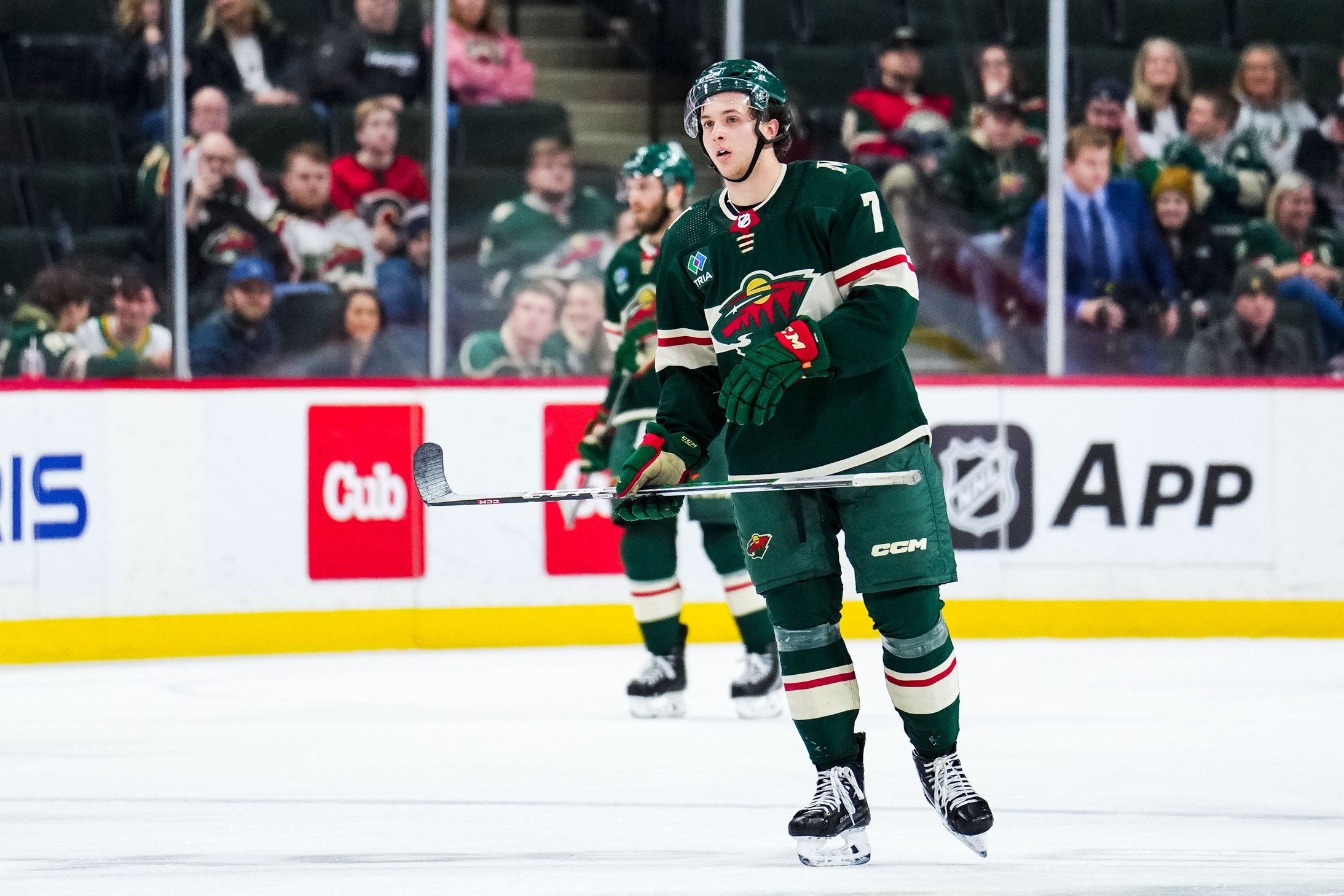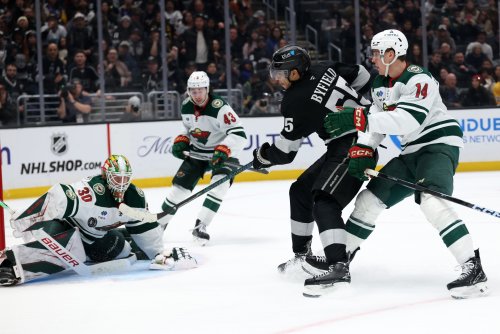
The ink has dried on Brock Faber’s contract, as well as the dozens of articles and blog posts, which all seem to agree.
The Minnesota Wild nailed it.
Faber’s contract guarantees eight more years of the hometown kid playing in St. Paul, and it’s almost certainly a positive-value contract. It also leaves room for spectacular upside. However, the contract is also fair to Faber because it guarantees him life-changing money. What a happy ending.
That’s all first-level analysis, though. To get to the second level, let’s examine how the deal affects the Wild’s team-building strategy. Viewed through that lens, the Faber contract may be the most interesting move of Bill Guerin’s tenure.
So, Faber’s market value is his on-ice value minus the value of those picks. Minnesota only needs to pay him his market value since they can match any offer from another team.
Faber remains an RFA until he’s 27 on July 1, which won’t happen until July 2030. Minnesota can retain Faber for a price well below his on-ice value for the 2025-26, 2026-27, 2027-28, 2028-29, and 2029-30 seasons. Based on the contract model developed by Dom Luszczyszyn at The Athletic, Faber gave up around $1.7 million per year over eight years for a total projected value of about $13.6 million.
Since underpaying Faber is a foregone conclusion, the question becomes: which years does Guerin want to save that $13 million? If the Wild extended Faber for only those five RFA seasons (2025-26 through 2029-2030), they could concentrate that cap savings to an average of about $2.7 million.
The total savings in those years would be much more than that. In cases like this, UFA years are more expensive than RFA years because Minnesota has less leverage. For every UFA year that they add to the deal, Faber’s agents will increase the average value of the contract, which drives up the cap hit.
If we take Faber’s projected value in those five RFA seasons ($9.5 million per year) and subtract Minnesota's 13.6 million-dollar leverage, the Wild could push the cap hit of this deal below $7 million for those five years. Then Faber would cash in a massive UFA deal starting in his age-28 season.

Ultimately, by signing Faber to an eight-year deal that buys some of his UFA years, Minnesota will cost itself about $1.5 to $2 million per year over the first five years of its lifetime. Perhaps that money won’t be enough to bring in a new player, but it would be enough to give a significant raise to a middle-of-the-lineup free agent.
In free agency, that $1.5 to $2 million is the difference between a third-line forward and a second-liner or between a third-pair or second-pair defenseman. With Kaprizov up for extension in 2026-27, a worse supporting cast could affect Minnesota’s ability to bring in the necessary support to keep their Russian sniper signed through his prime.

Graph Credit: Dom Luszczyszyn at The Athletic
That doesn’t mean the Faber extension spells the end of Kaprizov’s time in Minnesota. Instead, it implies that Guerin has a plan to make up that impact through the prospect pool.
The Wild roster will churn several players by the 2026 offseason. Mats Zuccarello will enter free agency as he turns 39. Zach Bogosian will be a 36-year-old free agent, and Jon Merrill will be a fond and distant memory. Marcus Johansson likely departs in 2025. If all four players depart, that clears $8.5 million in cap space.
Danila Yurov, Riley Heidt, and Liam Ohgren are ready to replace this group. On the back end, one or two defensemen, Jack Peart, Carson Lambos, Daemon Hunt, and David Spacek, can fit into a bottom-four role, and Zeev Buium will likely push for a top-four role.
If you’re keeping score, that’s two forwards and two defensemen who cost about $8.5 million replaced by three forwards and two or three defensemen, all at a cost-controlled rate. Jesper Wallsted, Marco Rossi, and Marat Khusnutdinov will be due raises by then, but still cost-effective RFA deals. UFA extensions for Filip Gustavsson and Declan Chisholm will be due a raise in unrestricted free agency. However, they can replace Chisholm with one of Iowa’s defensemen.
Then, you must factor in a projected 3% cap inflation over the next two years, creating an extra $5.4 million of space. With the space cleared by the Bogosian, Merrill, Zuccarello, and Johansson departures, that’s $13.9 million to pay four rookies and give raises to Rossi, Khusnutdinov, Gustavsson, Wallstedt and maybe Chisholm. The rest goes towards Kaprizov’s raise.
The only logjam here would be if Minnesota has too many prospects ready to join the NHL and too many players on the roster. However, Guerin also has an out for that. Each of the following players has limited no-trade clauses (NTC), which means the Wild can trade them to any team except their 10- or 15-team no-trade list: Marcus Foligno (15-team NTC), Ryan Harman (10 teams), Frederick Gaudreau (15), Jared Spurgeon (10), Jacob Middleton (15), or Jonas Brodin (no-trade protection).
Depending on how these players age and the roles the rookies can fill, Guerin can trade these players to between 17 and 22 other NHL teams that are not on that player’s no-trade list.
However, those trades may not favor Minnesota in a vacuum. They may need to retain salary or accept less-than-optimal trade compensation. But if it’s all in the name of clearing cap space to sign a premium free agent in 2026 to play alongside Kirill Kaprizov, that roster could be a Stanley Cup favorite. Nobody cares if the Wild have to dump a few Day 2 draft picks to clear cap space in the name of a few deep playoff runs.
Or, if the Wild prospects don’t develop into roles in the top half of the lineup, Guerin has the flexibility to retain those players rather than trade them and still ice a roster that can push for the playoffs. If Guerin (or if Minnesota's Cup window evaporates, his replacement) needs to hit the reset button, Faber’s extension will be unbelievably cheap in its final three seasons. If Kaprizov walks in 2026, Faber could be the foundation of a championship roster in 2030-31, ‘31-32, and ‘32-33.
That leaves the roster with a reasonable floor and a fairly high ceiling. If the team needs to dump veteran contracts to create space, going all-in will be more expensive if and when the prospects are ready to make a run at the Stanley Cup. The upside is that if the kids fail to live up to high expectations, the team won’t be forced into a hard rebuild around a bottom-five roster.
Overall, it seems Guerin has opted for a safer strategy with a strong possibility of ending in a roster that can compete for a Cup. To do so, Guerin has committed early to his best young players and extended key veterans as insurance against a future in which Minnesota’s prospects don’t develop well. That may have pushed the window out one more year to 2026-27, but it leaves room to save the roster even if a whole lot goes wrong.
And if everything does go wrong, Brock Faber will be there to hold things together.
Think you could write a story like this? Hockey Wilderness wants you to develop your voice, find an audience, and we'll pay you to do it. Just fill out this form.
-
 4
4
-
 2
2



.thumb.jpg.3818a5c4985e878d5ecaf2e7234883d8.jpg)



Recommended Comments
Join the conversation
You can post now and register later. If you have an account, sign in now to post with your account.
Note: Your post will require moderator approval before it will be visible.